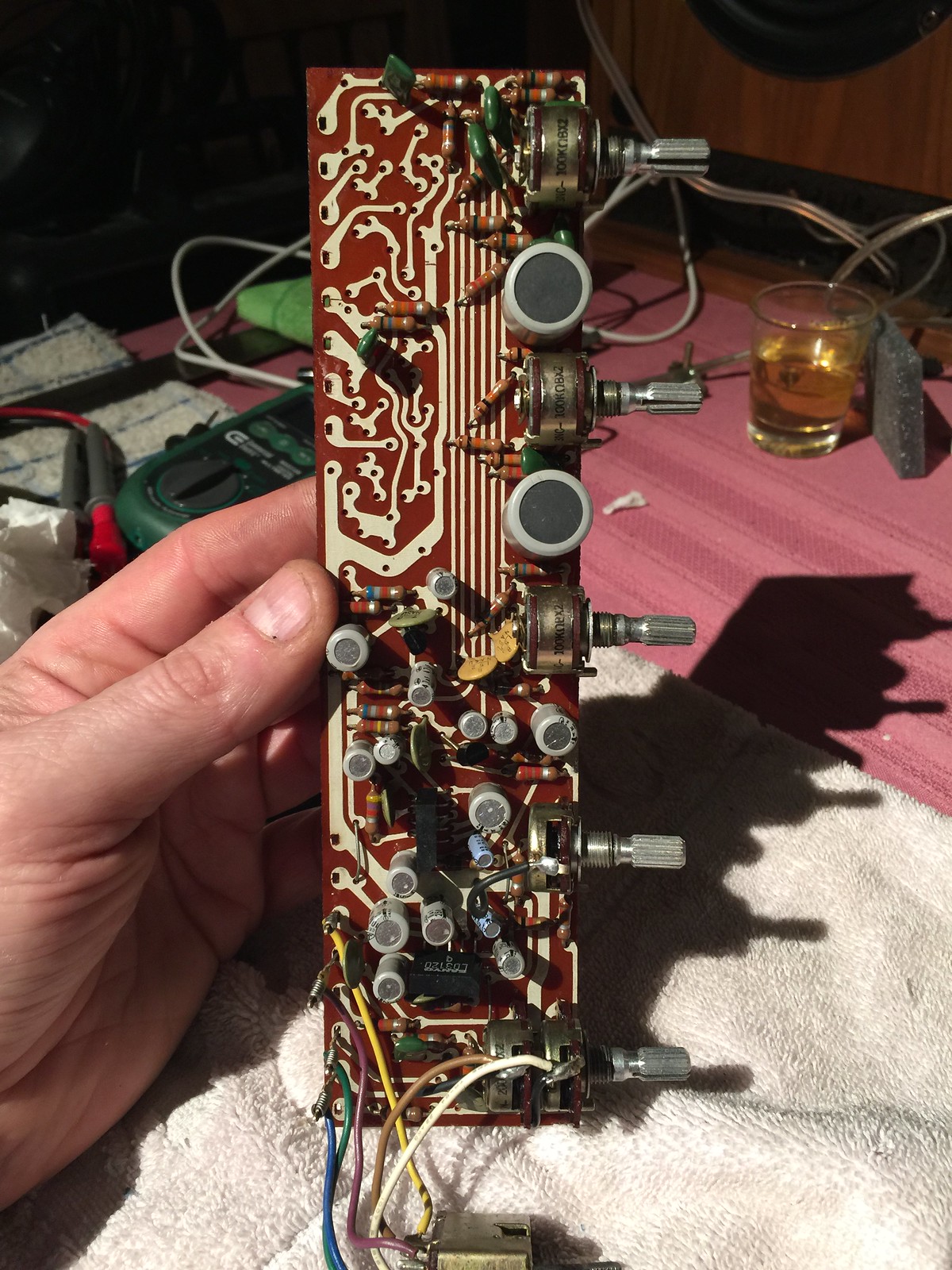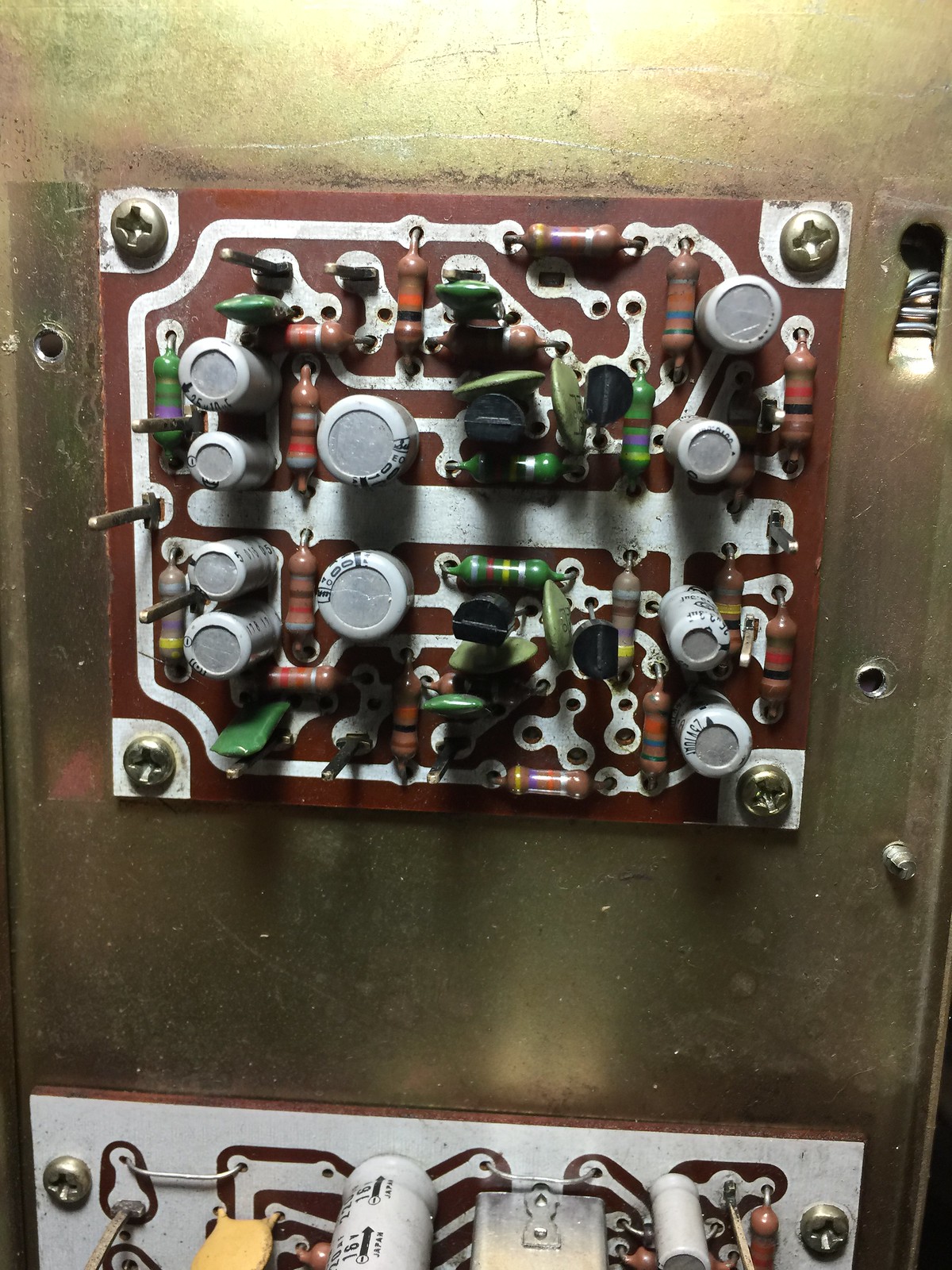nashou
Unmoderated Off Topic
Tech in Training.....
Posts: 1,239 
|
Post by nashou on Mar 22, 2019 21:54:09 GMT -5
You can try the 500 ohm ones but the DC may go up instead of down. But see what happens. Yeah it went up to where it was before . This is with your resistor and cap and the added 500 ohm resistors on the relay board. Would going down in resistance on the relay board reduce it then? I think I'll go back to the original resistors and then we can play with the values of the resistor on the Neg cap legs of the caps maybe? One more thing. What would cause the DC to go down after I accidentally short some pins on that socket while probing ( orange to yellow I think)? The relay clicks off then back on and DC at output is way down , but slowly climbs and eventually after lots of time back to 3 and 5 volts dc. |
|
nashou
Unmoderated Off Topic
Tech in Training.....
Posts: 1,239 
|
Post by nashou on Mar 22, 2019 22:16:40 GMT -5
Mac, I found this post over on AudioKarma. I think that this amp is the same as what this member is taking about. 15v DC on the speaker outputsHe is stating that you test the DC offset with a load connected. And he mentions the Amp that you used for the schematic earlier, the Marantz 2230 . What say you? Nashou |
|
|
|
Post by mastertech on Mar 23, 2019 10:49:23 GMT -5
Ok, here's the thing. Even though you are reading DC voltage on the speaker connectors it is (phantom) voltage. Because of the cap in series there is not a direct connection to the DC line voltage on the out line. So there is no DC current at the speaker connector which is why as soon as you connect something to it all is gone. I would think those resistors on the relay board should take care of this phantom voltage but your still get a reading. This is why i asked if you had another volt meter to test with because some meters will act different then others. So altho I am not thrilled with what your meter is telling us it appears after all your test that it should be ok to run the amp like this as long as the sound output is good. Again, this could be just your meters but there is surely no DC current there because of those caps. Maybe hook it all up and play something for a while and see if the speaker coils get hot. Just not to much bass as this may heat them up somewhat normally.
|
|
nashou
Unmoderated Off Topic
Tech in Training.....
Posts: 1,239 
|
Post by nashou on Mar 23, 2019 14:06:15 GMT -5
Ok, here's the thing. Even though you are reading DC voltage on the speaker connectors it is (phantom) voltage. Because of the cap in series there is not a direct connection to the DC line voltage on the out line. So there is no DC current at the speaker connector which is why as soon as you connect something to it all is gone. I would think those resistors on the relay board should take care of this phantom voltage but your still get a reading. This is why i asked if you had another volt meter to test with because some meters will act different then others. So altho I am not thrilled with what your meter is telling us it appears after all your test that it should be ok to run the amp like this as long as the sound output is good. Again, this could be just your meters but there is surely no DC current there because of those caps. Maybe hook it all up and play something for a while and see if the speaker coils get hot. Just not to much bass as this may heat them up somewhat normally. Would an analog meter be better for measuring amp designs like this? I need to add one to my equipment list as some times they come in handy compared to Dmm's. Nashou |
|
nashou
Unmoderated Off Topic
Tech in Training.....
Posts: 1,239 
|
Post by nashou on Mar 23, 2019 21:18:47 GMT -5
Ok, replaced the original filter cap. left the resistor and cap to GND connected . It has been playing for about 30 minutes and the amps are not even getting warm?!?! Is that suppose to be ? I figured they'd get at least a little warm. about 85-88° Also i hardly have to raise volume for it to blast and it distorts obviously from being over driven. Volume is pretty clear only at about 8 O'clock and its minimum is between 6 and 7 . At 9 O'clock its pretty loud but still clear. I think this time its the preamp section . This is with auxiliary and the phono sections and tuner. So I ask, how important is the bias voltage for proper sound quality, I assume very. Do you think maybe 5 mV's is too little and maybe bump it up ? How would I test this? I read this Article and found it interesting. Tomorrow I may try to raise bias. How can I figure out the bias of these transistors with the data we have from the data sheets, or is that not possible? Athanasios. |
|
|
|
Post by mastertech on Mar 24, 2019 14:29:02 GMT -5
Well I skim read that article and found nothing surprising. As far as your questions I have no specific answers. You still don't even know what those pots are really adjusting. You keep saying bias but there has been no prof of that. I don't know what they are adjusting only that you are reading some changes at a location. But it sounds like it is working. What seems to be the problem?
|
|
nashou
Unmoderated Off Topic
Tech in Training.....
Posts: 1,239 
|
Post by nashou on Mar 24, 2019 20:19:52 GMT -5
Well I skim read that article and found nothing surprising. As far as your questions I have no specific answers. You still don't even know what those pots are really adjusting. You keep saying bias but there has been no prof of that. I don't know what they are adjusting only that you are reading some changes at a location. But it sounds like it is working. What seems to be the problem? I figured out why it didn't sound right and had distortion. Something in the pre amp section. I decided to use my iPhone as the preamp . No distortion at all and the amps in here sound really good even with the iPhones crappy pre amp. So now I am going to take that out and check transistors and caps etc. ugh more work but also more learning!!!! I love learning and You Mac are a great teacher. Thanks so far So now off to start removing the preamp board. And to do that the whole from needs to come off to get to it. Thing I hate about pre amp boards is all the parts connected to them. Any suggestions as to what parts to check first? Probably the transistors correct? With the volume up at higher volumes with no input you could hear two things. Hum that would get louder as volume increased and the same with just scratchy noise or distortion. Athanasios |
|
|
|
Post by mastertech on Mar 24, 2019 20:36:36 GMT -5
You are welcome.  When you say with no input, did you try with the preamp/amp jumpers removed? Some hum may be normal in this type amp. Is the AC plug 2 prong? |
|
nashou
Unmoderated Off Topic
Tech in Training.....
Posts: 1,239 
|
Post by nashou on Mar 24, 2019 21:04:43 GMT -5
You are welcome.  When you say with no input, did you try with the preamp/amp jumpers removed? Some hum may be normal in this type amp. Is the AC plug 2 prong? Yes jumpers removed , and it is a two prong plug. nashou |
|
|
|
Post by mastertech on Mar 24, 2019 21:16:55 GMT -5
Also remember distortion and/or scratchy can be volume control needs cleaning or even any other manual control or switch.
|
|
nashou
Unmoderated Off Topic
Tech in Training.....
Posts: 1,239 
|
Post by nashou on Mar 24, 2019 21:32:20 GMT -5
Also remember distortion and/or scratchy can be volume control needs cleaning or even any other manual control or switch. Yes, i am going to go through that as well. Thought I did clean them well as adjusting them while playing amp I heard no scratchy doing than. But I did on the Tape monitor switches but not too bad. I think what I removed is more of the tone board. have to look for other boards that might be the pre amp, or maybe this is it?  |
|
nashou
Unmoderated Off Topic
Tech in Training.....
Posts: 1,239 
|
Post by nashou on Mar 24, 2019 21:37:44 GMT -5
unless this is it, under the silver box in the one photo of the entire amp .   |
|
nashou
Unmoderated Off Topic
Tech in Training.....
Posts: 1,239 
|
Post by nashou on Mar 24, 2019 21:49:39 GMT -5
one part on the board is a Sanyo LD3120 Integrated Circuit 9 Pin ZIP audio preamplifier with equalizer Replaces ECG1019 What is this part for? Is is then the preamp board ? |
|
|
|
Post by mastertech on Mar 25, 2019 10:22:31 GMT -5
Reference only.  |
|
nashou
Unmoderated Off Topic
Tech in Training.....
Posts: 1,239 
|
Post by nashou on Mar 25, 2019 13:08:47 GMT -5
Reference only.  Thanks Mac, I've looked for noise issues others may have had with that part, but have not seen it discussed. Do you have any experience with that part? Also What is that other board, the smaller board , the one under the metal cover? Equalizer/Phono board? Nashou |
|